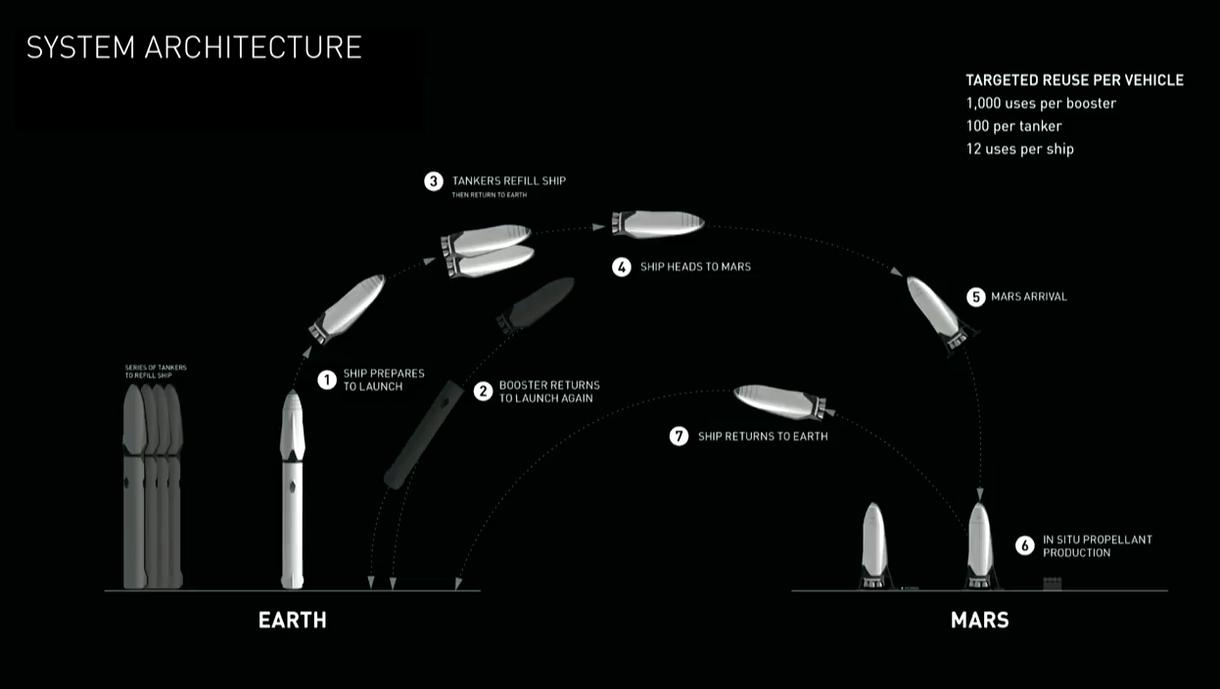On Septemeber 27th, Visionary and CEO of SpaceX Elon Musk, publicly announced his legendary plan to begin a human colony eventually amounting to 1 million people, on Mars. His thoughts are as follows “What I really want to do here is to make Mars seem possible — make it seem as though it’s something that we could do in our lifetimes, and that you can go,” (Wall, 2016). Clearly, this is a massive undertaking that will require meticulous planning and a lot of money, which Musk states will total to approximately 10 Billion USD (Wall, 2016).
The Interplanetary Transport System model works as shown in the image, which also shows the targeted re-use per vehicle (an aspect which will shed billions in costs).
 The ticket to board the repeated ITS trips, set to undergo their first journey in the next 10 years will cost you anywhere from $100,000 – $200,000. This is not to mention the fact that losing your life is a possibility and a probability to some extent. One of the most important factors of the project to take into account is the fact that it will not be a one way trip. “The ITS spaceships will be refueled on Mars and will launch back to Earth from there, meaning prospective colonists don’t have to stay on the Red Planet forever if they don’t want to.”
The ticket to board the repeated ITS trips, set to undergo their first journey in the next 10 years will cost you anywhere from $100,000 – $200,000. This is not to mention the fact that losing your life is a possibility and a probability to some extent. One of the most important factors of the project to take into account is the fact that it will not be a one way trip. “The ITS spaceships will be refueled on Mars and will launch back to Earth from there, meaning prospective colonists don’t have to stay on the Red Planet forever if they don’t want to.”
 In his statement, Musk only touched upon the first step towards colonization after transportation. This is the plan to build a Solar powered factory, which will use both carbon dioxide in the air and ice beneath the surface to create methane and oxygen.
In his statement, Musk only touched upon the first step towards colonization after transportation. This is the plan to build a Solar powered factory, which will use both carbon dioxide in the air and ice beneath the surface to create methane and oxygen.
Personally, I am a huge fan of this endeavour and commend Musk and SpaceX for their efforts which will eventually benefit us all. Yet in terms of the logistics and feasibility, the plan is a hollow shell which needs to be filled. The 10 year goal is basically impossible due to current technological constraints on the size of ships, and the massive amounts of undiscovered variables that will require additional time, money and planning. In other words, more and more unforeseen problems will arise throughout planning, and they will not require simple solutions. Astrophysicist Neil deGrasse Tyson said: “One, it is very expensive. Two, it is very dangerous to do it first. Three, there is essentially no return on that investment that you’ve put in for having done it first” (Plenke, 2016).
The plan has many critics, and only time will tell how Musk and SpaceX will respond and resolve tribulations that will arise.
“The objective is to become a spacefaring civilization and a multiplanet species,” (Wall, 2016) Musk stated.
Word Count: 440
References (APA):
[Mars]. (n.d.). Retrieved October 2, 2016, from http://www.seti.org/sites/default/files/martian-20th-century-fox.jpg
[System Architecture]. (n.d.). Retrieved October 2, 2016, from http://www.space.com/images/i/000/058/672/original/spacex-mars-interplanetary-transport-mission-profile.jpg?1475006320?interpolation=lanczos-none&downsize=*:1400
Plenke, M. (2016, September 29). Elon Musk wants to colonize Mars. “Good luck,” say critics. Retrieved October 02, 2016, from https://mic.com/articles/155485/elon-musk-wants-to-colonize-mars-good-luck-say-critics#.VXhjm2RlG
Wall, M. D. (2016, September 27). SpaceX’s Elon Musk Unveils Interplanetary Spaceship to Colonize Mars. Retrieved October 02, 2016, from http://www.space.com/34210-elon-musk-unveils-spacex-mars-colony-ship.html